The year was 1844 and Van Diemen’s Land had a problem. Its prison system was overcrowded and convicts who’d earned a Ticket of Leave were unable to find anywhere to work.
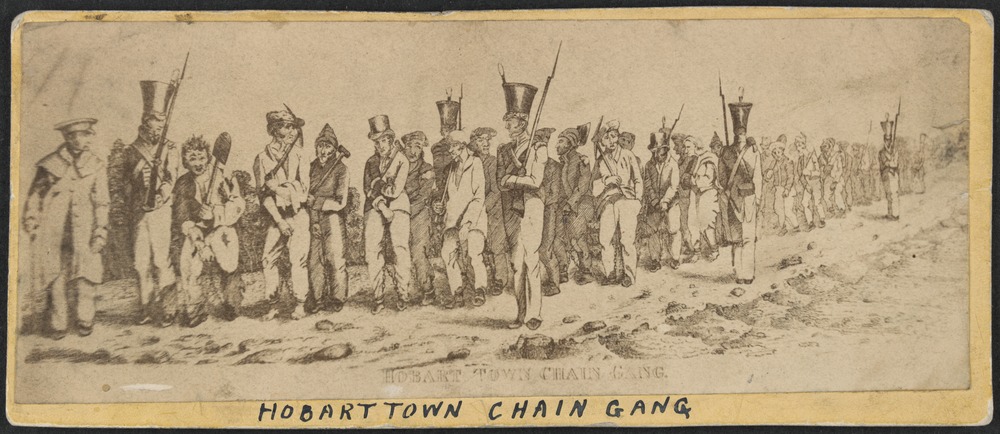 Hobart Town chain gang [picture]; H2408
Hobart Town chain gang [picture]; H2408
In Britain, things were even worse. Industrialisation, job losses and spiralling crime rates meant there would be no respite for England’s overcrowded jails. Transportation needed to continue, but how?
Lord Stanley, the Secretary of State for the Colonies, came up with the answer.
‘There is no sufficient reason’
he opined
‘why the better class of Prisoners, who have served the prescribed period of secluded punishment at Parkhurst and Pentonville, should be transported as Convicts at all… they may with equal advantage …be sent to Australia as Exiles.’[1]
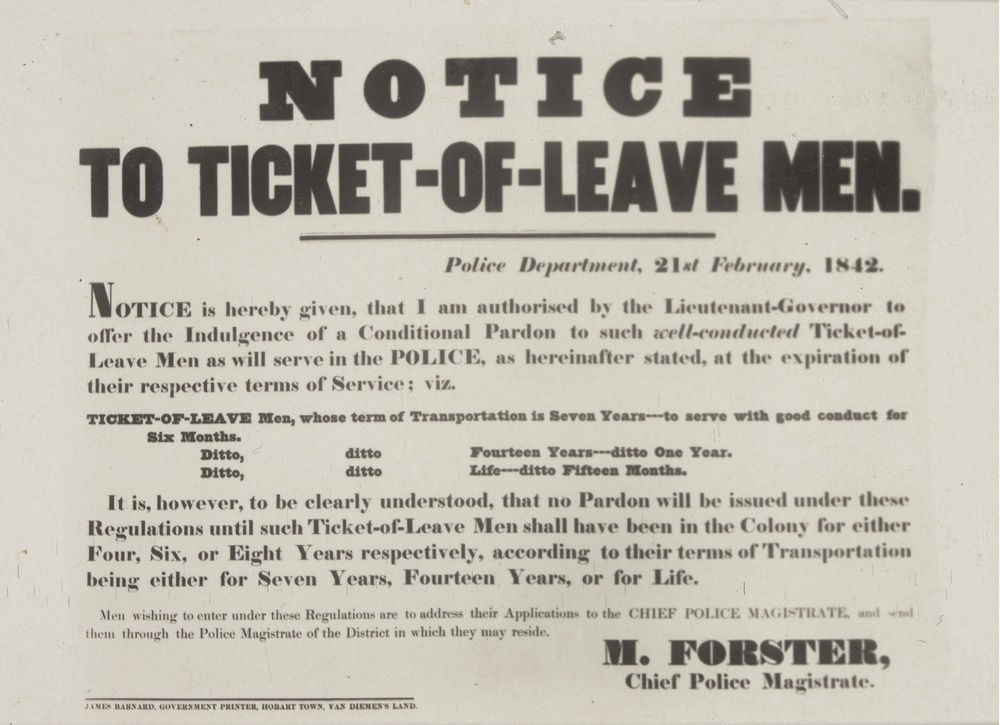 Notice to ticket-of-leave men [picture]; H22214
Notice to ticket-of-leave men [picture]; H22214
The exiles would be free men in Australia. The only condition to be placed upon them was that they must not return to England until their original sentences had expired.
And so it was that between the years of 1844 and 1849, around 1700 ‘exiles’ from England were sent to Melbourne, Portland and Geelong.
It was not all smooth sailing for Lord Stanley’s plan. Whilst the squatters were in favour of the idea (as the exiles provided much needed labour), Melbourne’s citizens were alarmed. ‘It will scarcely be believed’ the Port Phillip Patriot exclaimed. ‘This is a resumption of transportation with a vengeance… a regular letting loose upon us of the villainy of the mother country without check or hindrance’ (18 November 1844).
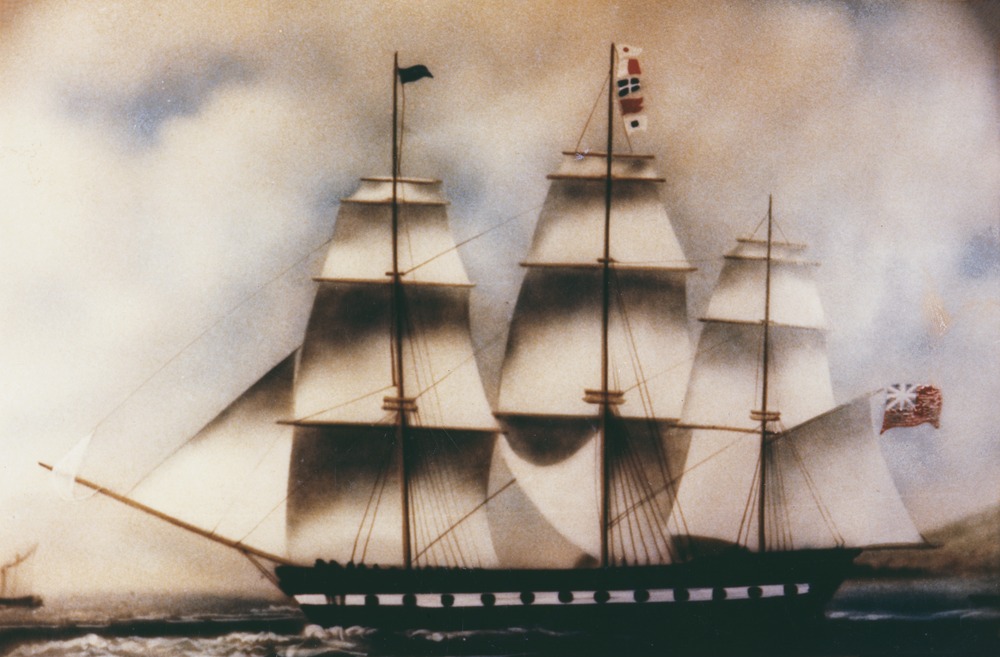 A convict ship; H92.410/20
A convict ship; H92.410/20
Public outcry in Geelong was similarly vehement: ‘Geelong…is doomed to the unenviable notoriety of being the ultimate destination of this cargo of fallen angels’ (Geelong Advertiser, 15 March 1845).
As the ships carrying the exiles continued to arrive, public sentiment became increasingly hostile. The Argus lamented that Port Phillip was being transformed into ‘a pandemonium, a very dung pit, for all the felons of the British empire’.
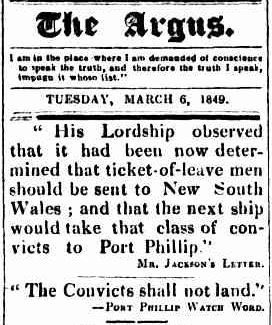 The Argus 6 March 1849, p.2
The Argus 6 March 1849, p.2
The controversy continued until finally, in 1849 a ‘monster meeting’ was held on the corner of Swanston and Collins Streets, where it was decided that ships containing the exiles would not be permitted to land.
‘The convicts shall not land’ The Argus newspaper headline asserted provocatively the following day.
The public did not have long to wait for its resolve to be tested. On the 8 August 1849, the Randolph ship arrived in Melbourne from England with 295 ‘exiles’ on board. The Argus implored people to be on their guard to ensure that the exiles were not landed. Superintendent Charles La Trobe refused to take the convicts and paid the ship’s captain to sail the ship on to Sydney.
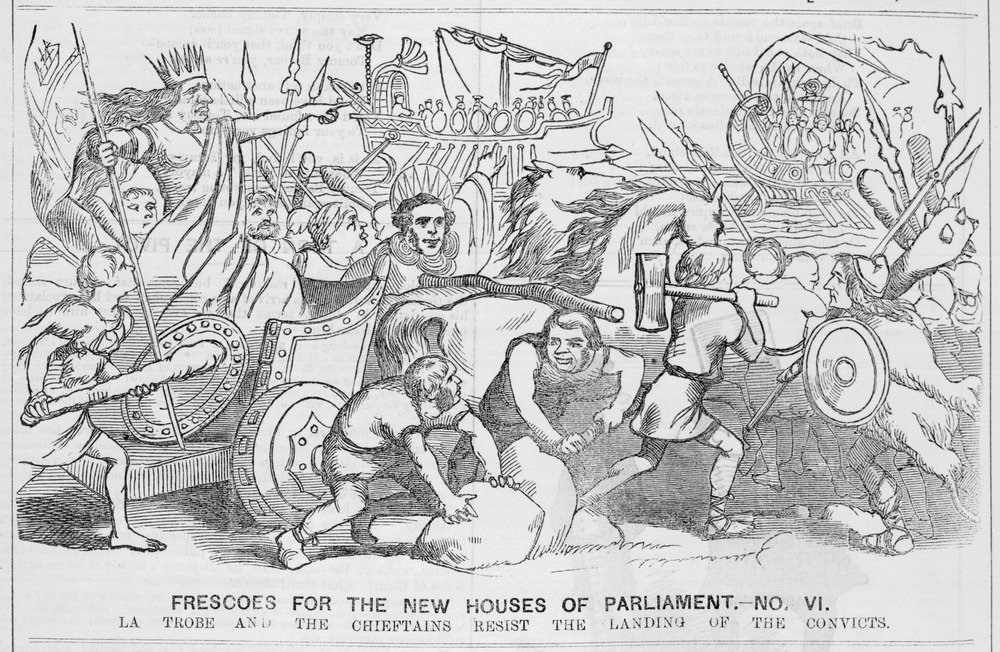 Frescoes for the new houses of parliament. no. VI [picture] ; La Trobe and the chieftains resist the landing of the convicts; MP15/05/56/116
Frescoes for the new houses of parliament. no. VI [picture] ; La Trobe and the chieftains resist the landing of the convicts; MP15/05/56/116
Despite this triumph, the Geelong Advertiser urged its readers to be vigilant, warning that ‘inhabitants of Port Phillip should not fall into the delusion that all danger is…past.’
Another ship – the Adelaide – arrived in December. Again, La Trobe refused to allow the ship to land, sending it on to Sydney instead. The Argus newspaper was positively crowing:
‘Today the harbour of Port Phillip will be happily freed from the second attempt made to render this province a receptacle for British crime, for the ‘Adelaide’ proceeds with her cargo of pollution to seek the more genial atmosphere of Sydney’.
By the end of 1849, five ships carrying exiles had reached the shores of Sydney. This was not to last however. Sydney soon joined Port Phillip in its uncompromising stance, and exiles were forced to land at Moreton Bay in Queensland.
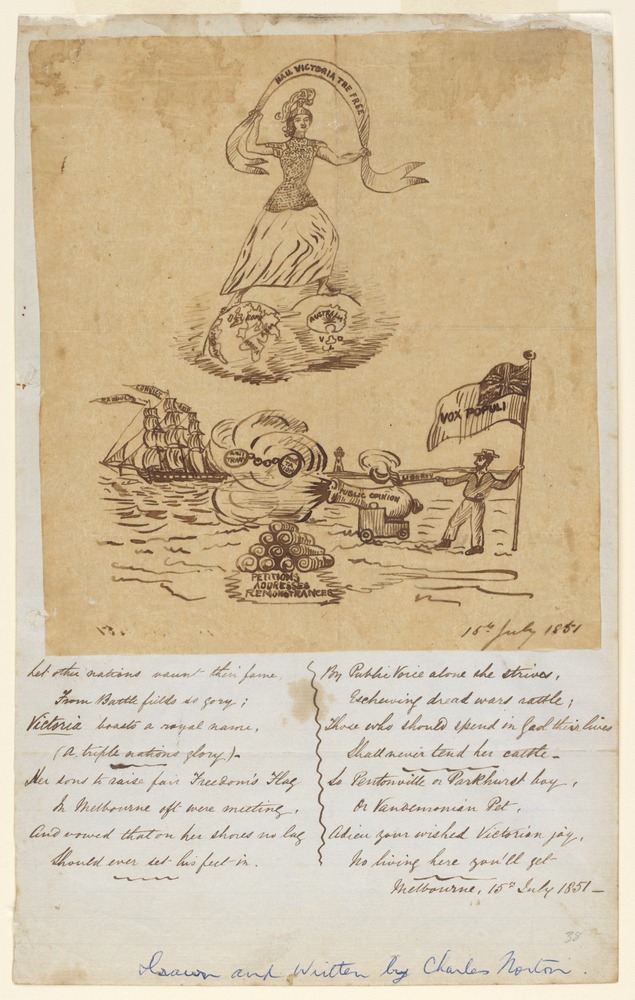 Hail Victoria the free [art original]. By Charles Norton; H88.21/87
Hail Victoria the free [art original]. By Charles Norton; H88.21/87
In the years that followed, the anti-transportation movement gathered apace, until finally, in December 1852, it was declared at an end.
So who were these cargo loads of fallen angels? According to historian Ian Wynd, the typical exile was:
‘… young, English, Protestant, single, and could read and write; he had been sentenced to seven or ten years’ transportation for a crime against property, most likely larceny; he probably came from an industrial area and had a trade learnt either before or during imprisonment.’[2]
Children too, were among the exiles. Francis Keener was just eleven years old. He had served four years already for stealing a shirt. Charles Jordan was seven when he was sentenced for stealing two pence, whilst 12 year old Joseph Rhymes was sentenced to ten years for stealing bees wax.
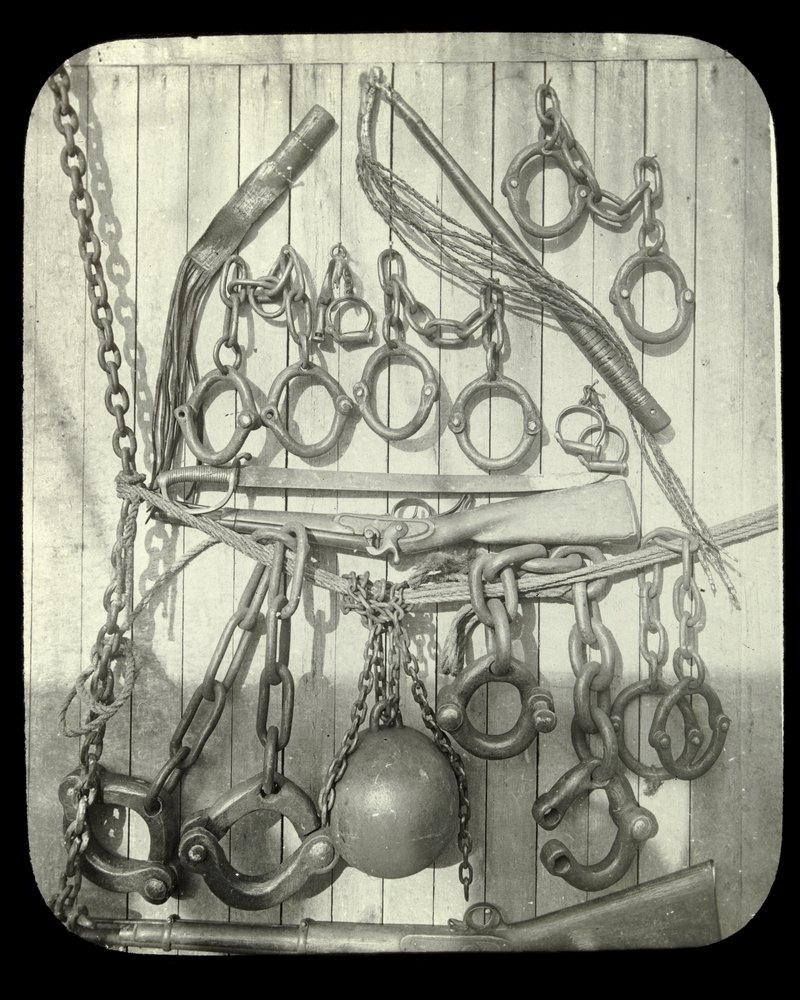 Relics of convict discipline [picture] ; H37687/4
Relics of convict discipline [picture] ; H37687/4
The story of the exiles was a challenging chapter in Australia’s history. It still resonates today.
References
[1] Historical Records of Australia (HRA), I, XXIII, p. 700, Stanley to Gipps, 27/7/1844
[2] Wynd, I., 1996, The Pentonvillains, Ian Wynd, Newtown, Victoria, p.
Further Reading
Dunstan, D. (ed.), 2000, Owen Suffolk’s Days of Crime and Years of Suffering, Australian Scholarly Publishing, Kew, Victoria
Wood, C., 2014, Great Britain’s Exiles Sent to Port Phillip, Australia, 1844-1849: Lord Stanley’s Experiment, University of Melbourne, Melbourne, Victoria
Wynd, I., 1996, The Pentonvillains, Ian Wynd, Newtown, Victoria


What an amazing piece of history – a parochial ‘operation sovereign borders’ all those years ago.
I do hope the ‘exiles’ faired well in Sydney after landing on Australian soil.
Wouldn’t it be wonderful to trace their progeny.
Thank you Sarah
Agree with Susan; a great read Sarah.
Tracing the descendants of convicts would be a big issue, as some 164 000 came to Australia between 1788 and 1868.
Perhaps we should return the kindness and send our worst misdemeanants to England.
I am a direct descendant of an exile. He was on the “joseph Somes” landing in Vic in 1847.
He went on to marry and have children. He resided in Geelong until his death in 1886 and operated a successful bullock & dray business. He became reasonably wealthy, owning several properties in the Bellarine area. He returned to England later in life.
Thanks Sarah. You have helped me understand a VDL ex-convict who went to Sydney in 1848, but later overlanded to Melbourne.. Port Phillip would have sounded rather hostile!
great work sarah, very impressive, looks like history can’t help repeating itself….
My GG Grandfather was on the “Adelaide”
Fascinating. Whilst researching Victorian gold rush history I noticed many newspaper articles expressing an attitude of disdain and prejudice against ex convicts from Tasmania and these exiles.
Thanks Sarah,
I have researched Thomas DREWERY who was sent as an exile to Melbourne
I believe Thomas was able to prove he was innocent- and was the only exile to receive a full pardon from Queen Victoria
Thomas DREWERY sailed on the Joseph Somes with Owen Suffolk, and is mentioned in his journal. Once in Melbourne he found work as a chemist. Later he was a Melbourne City Councillor, and the Melbourne lane, DREWERY Lane is named after him.
My article on Thomas was published online in the 2015 journal Provence, (PROV)
Dorothy
My GG Grandfather, John Brewer was an exile on the Sir Thomas Arbuthnot. His family petitioned for clemency and his wife petitioned for him to be sent to America where his uncle lived, but to no avail. He landed on his feet here in Victoria and ran the Black Bull Inn in Bourke Street and then the Royal Oak in Kyneton. Despite all his wife had done to try to help him, he married my GG grandmother in Melbourne and had another family. He was never all that far from strife though!
My G G G Grandfather John Price (1818 – 1888) was an exile on THE GEORGE SEYMOUR (1845) &was landed in Geelong where he had a family & lived out his days. Some of his descendants still live in Geelong.